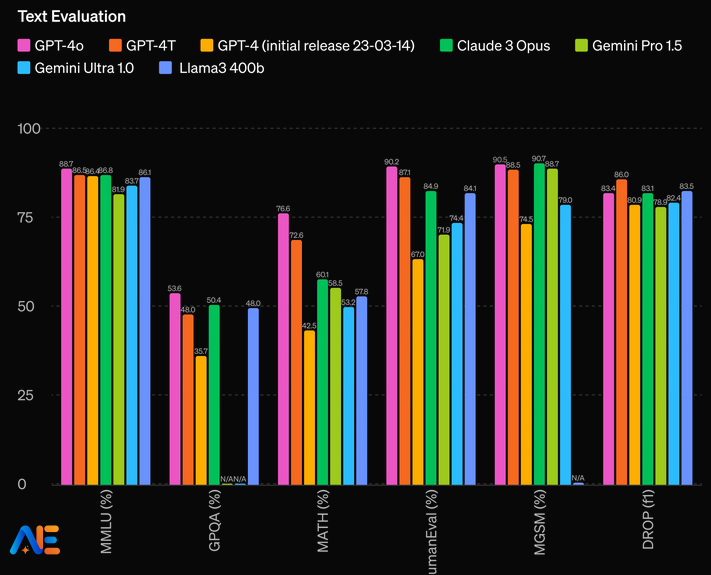Hello, dear educators! Today, we’re thrilled to share some exciting news that could revolutionise the way you interact with technology in your classrooms and beyond. The latest advancement in artificial intelligence, GPT-4o, has just been released, and it brings a host of new capabilities that promise to make your teaching experience more seamless, engaging, and efficient.
What is GPT-4o?
GPT-4o, where the “o” stands for “omni”, is a groundbreaking AI model developed by OpenAI. Unlike its predecessors, GPT-4o can process and generate text, audio, image, and video inputs and outputs in real-time. This means it can understand and respond to a variety of media formats almost as quickly as a human can.
With response times averaging around 320 milliseconds, GPT-4o is set to offer a more natural and interactive experience. 300 milliseconds is important as that is roughly the time it takes for a human to respond in conversation.
Key Features of GPT-4o
Multimodal Capabilities
GPT-4o is designed to handle multiple types of input and output, including:
- Text: Whether it’s reading a passage, writing an essay, or answering questions, GPT-4o excels at understanding and generating text.
- Audio: It can listen to spoken language, understand it, and even respond in kind. This opens up possibilities for real-time language translation, voice-activated commands, and more.
- Images and Video: GPT-4o can interpret visual information, making it capable of tasks like describing images, analysing videos, and even recognising objects and scenes.
This is different to previous models because under they hood there was actually multiple models working together to bring the functionality of “ChatGPT 4”. GPT-4o is a single model that can handle all of these tasks natively.

Speed and Efficiency
One of the standout features of GPT-4o is its speed. It can respond to audio inputs in as little as 232 milliseconds, with an average response time of 320 milliseconds. This is comparable to human response times in conversation, making interactions with the AI feel more fluid and less like talking to a machine.
Cost-Effectiveness
GPT-4o is not only faster but also 50% cheaper than its predecessor, GPT-4 Turbo, when accessed through the API. This makes it a more affordable option for educational institutions looking to integrate advanced AI into their systems.
While this does not affect OpenAI’s ChatGPT pricing, it does allow for an introduction of a new tier of ChatGPT that will put the power of GPT-4o into the hands of more users.
Practical Applications in Education
Enhanced Classroom Interactions
Imagine a classroom where students can ask questions in their native language, and the AI can understand and respond accurately. GPT-4o’s multilingual capabilities make this possible, breaking down language barriers and fostering a more inclusive learning environment.
Real-Time Feedback
With its ability to understand and generate text, audio, and visual content, GPT-4o can provide real-time feedback on student assignments, presentations, and even classroom discussions. This can help students improve their work on the spot and make learning more interactive.
Automated Administrative Tasks
Teachers often spend a significant amount of time on administrative tasks such as grading, scheduling, and communication with parents. GPT-4o can automate many of these tasks, freeing up more time for teachers to focus on instruction and student engagement.
Language Learning
For language teachers, GPT-4o offers a powerful tool for real-time translation and pronunciation feedback. Students can practice speaking and receive immediate corrections, making language learning more effective and engaging.
Safety and Limitations
OpenAI has taken significant steps to ensure the safety of GPT-4o. The model has built-in safety features across all modalities, including filtering training data and refining the model’s behaviour post-training. Extensive testing and red-teaming have been conducted to identify and mitigate risks, particularly those associated with audio outputs.
However, like any technology, GPT-4o has its limitations. While it excels in many areas, there may be specific tasks where GPT-4 Turbo still outperforms it. Continuous feedback from users will be essential in identifying these areas and further improving the model.
Availability and Access
GPT-4o is being rolled out in phases. Text and image capabilities are already available in ChatGPT, including the free tier, with extended features for Plus users. Voice Mode with GPT-4o will be available in alpha within ChatGPT Plus in the coming weeks. Developers can also access GPT-4o through the API, with support for audio and video capabilities expected to launch soon.
Conclusion
GPT-4o represents a significant leap forward in AI technology, offering educators a versatile and powerful tool to enhance teaching and learning. Its ability to understand and generate multiple types of media, combined with its speed and cost-effectiveness, makes it an invaluable asset for modern education.
We encourage you to explore GPT-4o and see how it can transform your classroom. Stay tuned for more updates and feel free to share your experiences and feedback with us. Together, we can harness the power of AI to create a brighter future for education.
Happy teaching!